By Arthur Painter (with notes from Tim Eldred)
When Star Blazers was adapted from Japan’s Space Battleship Yamato for American TV in the late 70s it had to conform to certain standards. Even as a kid, I was bothered by some of the things I saw in my then-favorite show. While they at least acknowledged death, I thought it was ridiculous that the Star Force could, say, storm into the Comet Empire fortress and blow up their energy center without one fatality. (I totally believed the line that Knox got out right behind Wildstar!) Of course, at the time, I had no idea of what really happened “behind the scenes.”
While I didn’t tune in at the very beginning (I don’t remember what episode of Star Blazers was my first), this episode certainly sets a very different tone from other “children’s programming” at the time. This was serialized television, for one thing. Not everything was resolved in a half an hour, or even in 20 half-hours! To find out what happened next, you had to tune in to the next episode. The stakes were high, too, with the fate of the entire Earth at stake! The animation was also much more grand and detailed than anything put out by Hanna-Barbera.
This series will compare and contrast Star Blazers with Space Battleship Yamato. The beginning is a good place to start, don’t you think?
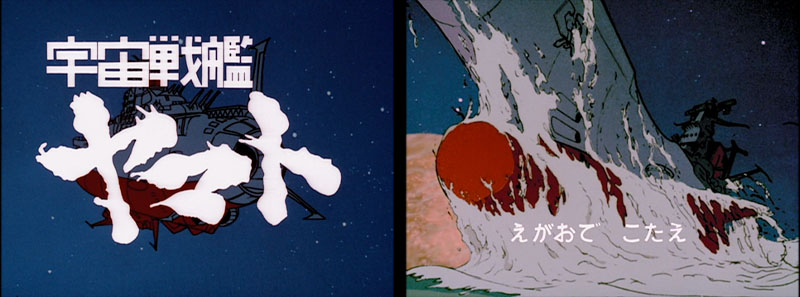
Episode 1
SOS Earth! Revive Space Cruiser Argo!
Production note: The broadcast time for the first run of the series in Japan was Sunday evenings at 7:30pm. Its competitors on other networks were the extremely popular Heidi Girl of the Alps and Ape Army, Japan’s live-action answer to Planet of the Apes. Unlike other anime programs, the first series of Space Battleship Yamato never had episodic title cards. The explanation was simple; during the rush of production on episode 1 there simply wasn’t time to make one. It therefore became the norm to leave it out on all subsequent episodes. The titles first became known thanks to dedicated fans who visited the animation studio and obtained copies of scripts. When the series was eventually released on home video, title cards were created as a lead-in for each show.
The opening theme, while I loved it as a kid, sounds very cheesy to my adult ears. While there is much to recommend about Hiroshi Miyagawa’s music (that opening fanfare certainly gets the blood stirring, doesn’t it?), the English lyrics, while they have a certain charm, knock it down a few points. The lyrics were written by Ginny Redington, a jingle writer who (I assume) was working for Griffin-Bacal Advertising at the time. Griffin-Bacal was also responsible for rewriting the Star Blazers script, as the translations originally provided to Westchester Films and Claster Productions were rather stiff and unidiomatic. Click here to read more about their work on the series.
Instead of using the credit sequence from Yamato, the Star Blazers production team created their own, using clips from various Series 1 episodes, especially episodes 7 (the Battle of Pluto) and 9 (the battle in the Minerva asteroid field).

The opening of Star Blazers episode 1 is a classic, with Captain Avatar gazing upon a near-dead Earth from his flagship. He’s overlooking what used to be the Pacific Ocean, which now appears to be just an empty, cratered basin. If you’re a fan, you can probably recite Avatar’s soliloquy by heart.
The narrator informs us that it’s the year 2199 and mysterious aliens called “Gamilons” have been invading known space since the middle of the 21st Century. I was always slightly confused by the point where it’s stated that Earth has only one space battleship left, only to see a whole fleet in the very next scene. I had to assume that “space battleship” was referring to a specific class of ship, as opposed to other named types like “missile ship” and “laser ship.”
Additional note from Matt Murray: This opening narration contains what might well be the biggest error in the entire series, though it’s also an easy one to overlook: the claim that the Gamilons declared war in the mid-21st century, which is of course our current century. This implies that the war has been ongoing for around a hundred and fifty years at the time the story begins. The scriptwriter likely mistook the year of 2199 as being the end of the 21st century, rather than the 22nd, though this still indicates a war that had been in progress for fifty years, but which had only begun to inflict serious devastation on Earth in the last decade (episode 13 shows our protagonist in his youth, when the Earth was still blue and major cities still stood on the surface.) In Yamato, the war had begun just ten years earlier.
I think part of my confusion (or the script’s confusion) is due to deliberate script changes. In Space Battleship Yamato, this episode starts with the battle of Pluto and viewers were thrown right into it with no indication of who the enemy was. This information is not revealed until the midpoint commercial break, when the flagship returns from the battle. (And at that point, Avatar’s ship truly was Earth’s last battleship.) When Star Blazers was translated for American TV, it must have been decided that such an opening would be too confusing to younger viewers, so the backstory was revealed in the introduction. I always thought it was curious that Avatar’s flagship isn’t given a proper name. It’s just called “225,” even in Japanese. For the Yamato 2199 remake, it was finally named Kirishima.
Continuity note: Going by flashbacks in later episodes, it can be surmised that the battle at Pluto takes place either late April or early May, 2199. As the series begins, Yamato is already being rebuilt from the inside out as an escape ship, and the remodeling of it to accommodate a Wave-Motion Engine is a process that takes five months. The Planet Bomb attack on Earth begins in 2190, according to information in episode 13, with Japan (or “The Great Island”) taking damage on April 20, 2192.
As the two sides face off near Pluto, the Gamilons give Avatar one chance to surrender, to which he simply replies, “IDIOTS.” This could be a reference to the Battle of the Bulge, where the Allied general’s one-word reply to the German surrender demand was “Nuts.” The scene was the same in Yamato, with Okita replying “bakame.”
The battle begins, and as Avatar realizes they can’t possibly win, a strange, unidentified ship flies through the battle area, moving at incredible speed. It is damaged and heading for a crash-landing on Mars. (A later episode states that the ship was damaged when it was fired upon by the Gamilons, although it’s not shown or referred to here.) The original show states that the alien ship covers the distance from Pluto to Mars within minutes. Earth Defense Forces HQ is notified of the incoming ship and they dispatch cadets Derek Wildstar and Mark Venture, stationed on Mars, to check out the crash site.
Production note: The original Japanese voice actor for Shima Daisuke [Mark Venture] was Shinji Nomura, who was replaced at the last minute by another actor named Hideo Nakamura. It was decided to recast him so that Shima would have a more even-tempered voice to contrast with the hot-headed Kodai. This later set the tone for the voice-casting in Star Blazers.

Some omissions: “Earth Defense HQ,” “EDF Commander,” and the “Mars Observatory” don’t get introductory captions as they do in Japanese. That’s a distinctive thing about Yamato–they love to label things.
One of the things I found when comparing Star Blazers to Space Battleship Yamato is that Star Blazers tends to be a bit more talky. In Yamato, from the time they land at the crash site to when they discover the body, Kodai (Wildstar) and Shima (Venture) don’t say a word. The only sound is the Martian wind. In Star Blazers, the two spend the whole time gabbing.
It’s interesting to see that Wildstar and Venture are wearing proper space suits in this episode, with full helmets that latch onto the collar. In future episodes, the crew often goes out (at least when planet-side) in their thin, cloth-like uniforms, wearing only a helmet with a face shield pulled down.
Additional note from Matt Murray: Such space suits are at least theoretically possible; one such suit currently in development can be seen here:

Meanwhile, back at the Pluto battle, Earth ships continue to crackle and explode. Avatar’s flagship takes some hits, including one on the bridge. Scenes of crewmen getting caught in explosions and sucked out of corridors were removed. Instead, Star Blazers just shows us an electrical flare-up on a control panel.
Production note: The battle at Pluto is considered an early anime masterpiece for its skillful consideration of zero-G tactics, weightlessness, and special effects. Moreover, a number of scenes in the second half of the episode were very unusual for low-budget TV anime at the time, such as the art direction on Kodai and Shima and the single-frame animation of their scene on the escalator. Unfortunately, scenes like this utterly destroyed the schedule and put the rest of the series permanently behind.
Avatar orders a retreat and Alex Wildstar’s response to the order is a resigned “Sure, Captain, I’ll bring up the rear. You’re unprotected. See you later.” Avatar doesn’t stand for that kind of insubordination, and insists that Wildstar retreat with the flagship. Earth needs protecting, he argues. Wildstar responds with a great line: “It’s just a simple matter of mathematics, sir. There are 470 men on your flagship, there are 20 in our ship. You’ll get back to Earth. We’ll see to it!”
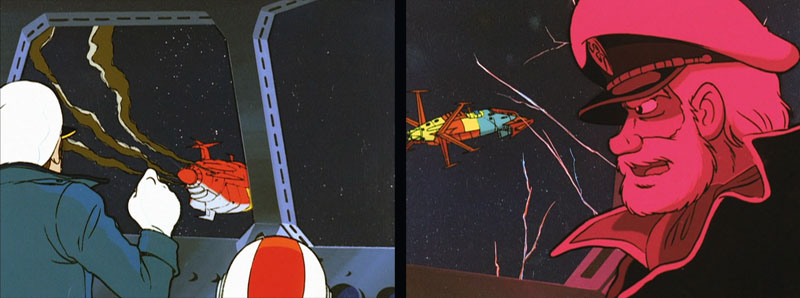
The Yamato version of Alex Wildstar’s last stand is all about pride and honor. No mention is made of “a simple matter of mathematics” or even any implication that he’s attempting to protect the flagship. Mamoru Kodai simply couldn’t face the shame of retreat and remained behind. Okita asks him to swallow his warrior’s pride, as the fate of the entire Earth is at stake. Kodai refuses. It’s a very emotional scene, with the two Captains pleading with each other, each insisting that they are doing what must be done.
I must say, I’m much more sympathetic to the Star Blazers version. Even though it had the same end result, Wildstar comes off much better than his Yamato counterpart. While they both disobeyed orders, Alex Wildstar gave the lives of himself and his crew to insure the flagship’s survival (as is expected of an escort ship), while Mamoru Kodai threw away his men and ship for the sake of personal pride and a misplaced sense of honor.
The number of men on the flagship, 470, appears to be made up out of whole cloth by Griffin-Bacal. The two ships really didn’t have a great difference in size or crew complements. The only definite number I could find was from the Star Blazers Warship Recognition Guide, which reports that Avatar’s flagship had a crew of 25, only 5 more than Wildstar’s ship. I’m not sure if the SBWRG based that number off of a Japanese source, but seeing as the author didn’t list 470, I imagine he did. However, for the purposes of the Star Blazers script, a larger difference in numbers was necessary in order to justify Wildstar’s actions.
Some time after the Pluto battle (3 days, according to Yamato–those ships can really move!) Avatar’s flagship arrives at Mars to pick up cadets Derek Wildstar and Mark Venture before heading back to Earth. While approaching Avatar’s ship in a small recon craft, Wildstar wonders why there are no other ships around. Surely, his brother Alex’s ship should be nearby. From the dialogue, it sounds like Wildstar expected his brother’s ship to be in the flagship’s hangar bay, which would be impossible given the relative sizes of the two ships.
After the commercial break point, we get another look at Earth. For viewers in Japan, this was their first look at “chikyu” (Earth).
Production note: The vivid image of a red Earth with all the seas dried up was visually shocking at the time of the original broadcast. One of the reasons for its chilling realism was that it was based on a geographically-accurate painting in an issue of Life Magazine that exposed such things as the trenches in Earth’s seabeds.
The flagship pulls into the underground dock. Wildstar and Venture disembark, then board an elevator to descend to the underground cities. A few scenes of the elevator’s descent were removed from Star Blazers.
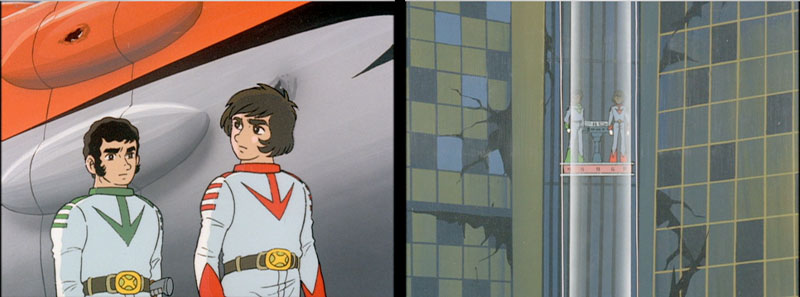
Production note: The origin of Wildstar and Venture’s uniforms before the founding of the Star Force remains a mystery. It’s possible they were the uniform of Earth’s special forces in the space navy, but no official reason has been stated. We will also see the red/white version of this uniform on Captain Avatar’s son in the family photo.
The cadets drop off the recovered message capsule at the Commander’s office. He mentions the Inter-Space Committee, a group that may have been the precursor to the Earth Defense Forces. They get their first look at Nova, who reminds them of the mysterious woman on Mars (notice the furtive glance she casts Wildstar’s way as she passes), then run into the eccentric Dr. Sane (who’s wrestling with a pig), and self-described “genius robot” IQ-9.
Production note: in Yamato, IQ-9/Analyzer went unnamed in the first episode, and was merely listed as “Robot” in the end credits until episode 3 when the name “Analyzer” first appeared.
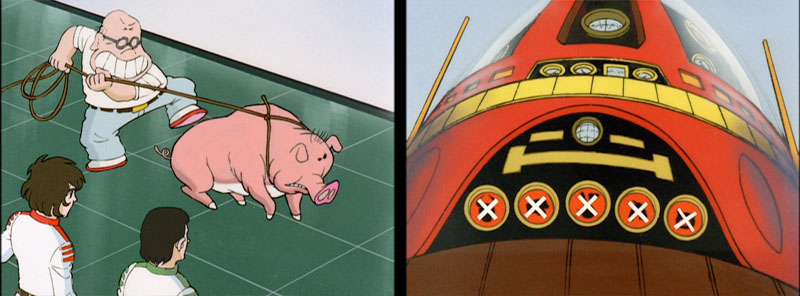
Here we have another example of how the Star Blazers script makes some improvements over the original. The Yamato version of this scene with Dr. Sado (Dr. Sane) and the pig was just downright morbid. The original dialogue indicated that Sado was going to operate on the pig. After dragging it into another room, Dr. Sado emerged less than a minute later to declare that he botched the operation. Analyzer informs him it’s his 5th failure in a row. So, what are we to make of Dr. Sado? Is he an incompetent vet that also treats humans? Is he a Medical Doctor with the bizarre hobby of pig surgery? Based on this first meeting, the Yamato would have been better off with The Simpsons’ Dr. Nick. The Star Blazers script informs us that Dr. Sane “keeps all kinds of pets, including pigs”. Rather than an operation, Sane was merely trying to drag the stubborn pig into the next room for a feeding.
The scene shifts to Avatar in his hospital room, being treated for his wounds from the battle. One notable thing about this scene is that Avatar is seen without his cap on. This is the only time we ever see him without it. In a future episode, he even leaves his hat on during surgery!
In the EDF Command Room, Avatar and Earth Defense Force (EDF) Commander Singleton listen to a message from Starsha of Iscandar, who offers Earth the Cosmo DNA (“Cosmo Cleaner D” in Yamato) which can magically restore Earth to its former glory. In the English version, Starsha specifically mentions plans for the revolutionary Wave-Motion Engine are contained with the message. In Yamato, the next scene has the Captain and Commander puzzling this out for themselves.
Story note: You can be forgiven at this point for asking why Starsha didn’t simply send plans for the Cosmo DNA. Fans have been pondering that one for decades, both in the US and Japan. Setting aside the fact that there wouldn’t have been much of a story if she did that, we have to assume that it simply wasn’t possible. Maybe some of the components could only be made on Iscandar (using Iscandarium?) so it couldn’t be built on Earth even with the plans. Maybe it was too risky to send components on a ship, because it could be destroyed by Gamilas and all hope would be lost. Even if these obstacles were overcome, Gamilas could simply resume planet-bombing after the Cosmo DNA was used and the whole thing would start over.
Then there is the far more satisfying spiritual answer, that Earth people had to prove themselves worthy of the Cosmo DNA by fighting for it. So Starsha gave them the best tool with which to fight.
As the groundwork is laid for the mission to come, there’s an alert about a Gamilon plane near the old hull of Yamato. Wildstar, looking for some action, talks Venture into coming along to shoot it down.
Like the scene in the elevator tube, there are a couple of alternate shots that were edited from Star Blazers, such as Avatar (with a slightly miscolored hat) turning to the camera at the alert, and Wildstar and Venture’s craft coming down the launch tube.
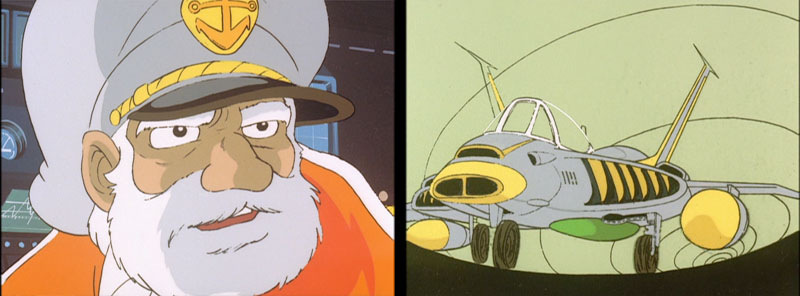
The pair soon spot the Gamilon recon plane and try to follow it, but their ship overheats and they crash on the dried-up plains that once were part of the East China Sea (simply called the Eastern Sea in Star Blazers). Walking back to base, they are stunned to see the ruins of the WWII battleship, Yamato.
The Japanese ending had a long, lingering view of the wreck as the narrator tries to coax the battleship out of its 260 year-long slumber. The Star Blazers version is much shorter, with the narrator simply asking, “What is the secret of this ancient battleship?”

Thus ends the first episode. This is definitely a different type of show than the typical weekday afternoon fare. Earth is dying, its last fleet has been lost, and the main characters have been defeated and demoralized. These are not the kind of problems that can be solved by a gang of meddling kids, even if they do have a talking dog. The only glimpses of hope were the message from Iscandar and the reveal of an obscure (to most American viewers anyway) WWII wreck. This was heavy drama, and the serialized nature of the program indicated that it wasn’t going to be an easy struggle. But to see what happened next, you had to watch the next episode…

Hello! I recently had the very fortunate luck to see the remastered edition of season one which was, I believe, remastered by Village Video and put out by Voyager. I noticed a great deal of footage cut from the Japanese source for the American localization was restored in this edition. Crew deaths, the final battle of the Yamato during WWII, IQ-9’s skirt flipping, Nova’s clothes vanishing during space warp, and so forth.
I can’t find any discussion on the process of restoring that footage or if the same treatment was given to the next two seasons. Could you give me some details? Thank you.
JGray – The Village Video Anime is definitely a fan edit. These commentaries actually started when I decided to rewatch Star Blazers, VVA’s Star Blazers Remastered, and a sub of Space Battleship Yamato and compare them, scene by scene. The result turned out to be quite different that a simple comparison. When Tim wanted to use my commentaries, one of the first rules is to take out any reference to fan edits, since we were posting them on starblazers.com, the official site.
I thought VVA made a good effort, but it gets a little to overboard with fannish stuff like labelling every character and ship that’s on screen for more than a second, especially in the Comet Empire.
There have been a few re-edits done over the years. Maybe there should be a separate article on them.
You’re describing a version that was not released by Voyager. It must have been a fan edit.
Who was the narrator for the American version? I can’t seem to find any credits reflecting that.
It sounds like Robert Stack.
Sounds like, but it isn’t. On the other hand, you can hear that same narrator on GI Joe toy commercials from the late 70s (for the 12″ Adventure Team Joes). Another Hasbro connection.
Yeah, sounds a little like the guy from the Superfriends
The Voyager home video version of episode 1 cuts short the ending with the Yamato wreckage looming large against the sunset and only says “what is the secret?”
The original broadcast version of Star Blazers and the original Kidmark VHS copy have a much longer sequence like in the original anime with the narrator saying “The Yamato was once a legendary ship. Now, time has removed her sleek beauty, the legend will come alive again. A legend and a ship that will save Earth!” …or something like that. Gotta pop in that tape again.
Anyway, I was really disappointed that Voyager changed this in their dvd release. That and the different opening and theme song footage. A shame, really.
Why did you not mention this fact in your article?
We left that for you to fill in. Thanks!
The original broadcast actually did end with “What IS the secret of this ancient battleship?” The longer piece of narration came at the beginning of episode two during a recap. The Kidmark version, I believe, merged the two episodes, since the second one repeated the first episode’s final scene in its entirety, the segued into the longer piece of description. The Voyager DVDs removed the recap, as they removed most of the recaps, an annoying practice for many home television releases.
spacecruiseryamato.com has a link to the “lost” narration
Star Blazers – ‘Lost’ Yamato Narration 02.29.2008
On their main page and a link at the very bottom of their audio page titled “STAR BLAZERS LOST NARRATION”
http://www.spacecruiseryamato.com/home/mp3/mp3.html
For the record. 🙂